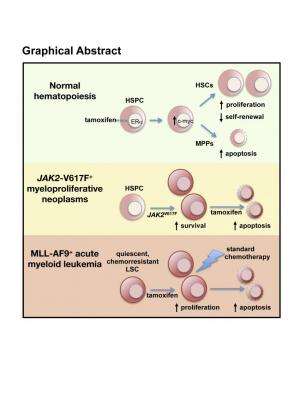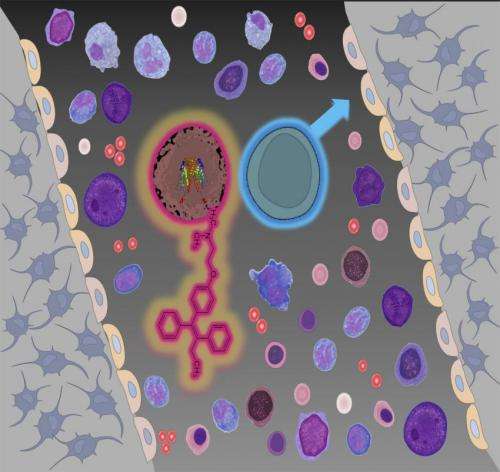Approved breast cancer drug offers hope for the treatment of blood disorders

Blood cancers are more common in men than in women, but it has not been clear why this is the case. A study published by Cell Press December 4th in Cell Stem Cell provides an explanation, revealing that female sex hormones called estrogens regulate the survival, proliferation, and self-renewal of stem cells that give rise to blood cancers. Moreover, findings in mice with blood neoplasms—the excessive production of certain blood cells—suggest that a drug called tamoxifen, which targets estrogen receptors and is approved for the treatment of breast cancer, may also be a valuable strategy for blocking the development of blood neoplasms in humans.
"Our study demonstrates that targeting estrogen signaling with a clinically approved drug, at doses with an acceptable toxicity profile in humans, provides a novel potential therapeutic strategy for a set of neoplasms currently without a definitive cure," said senior study author Simón Méndez-Ferrer of the National Center for Cardiovascular Research (CNIC) in Madrid, Spain.
Myeloproliferative neoplasms cause large numbers of abnormal white blood cells to be produced and enter the bloodstream, potentially causing life-threatening symptoms. These diseases can lead to cancer and arise from blood cells called hematopoietic stem/progenitor cells (HSPCs), which give rise to all of the other blood cells. Leukemia and other blood cancers are more common in men than in women, strongly suggesting that sex hormones such as estrogens contribute to the development of these malignancies. But until now, it has not been clear whether estrogen signaling could directly control normal and cancerous HSPCs.
In the new study, Méndez-Ferrer and Abel Sánchez-Aguilera of CNIC found that HSPCs express estrogen receptors, and activation of these receptors with tamoxifen affected the survival, proliferation, and self-renewal of these cells. In mice with a genetic mutation associated with blood neoplasms, tamoxifen treatment blocked the excessive production of blood cells by restoring normal levels of programmed cell death in mutant cells. Moreover, tamoxifen enhanced the effects of conventional chemotherapy on cancerous cells in a mouse model of leukemia.

"Our results suggest that tamoxifen, at a similar dose used for the treatment of other diseases, might be useful to treat myeloproliferative neoplasms at various stages, without being toxic to normal blood cells," Méndez-Ferrer says. "The fact that this drug is FDA-approved, readily available and sufficiently safe facilitates the potential translation of our results from the bench to the bedside."
More information: Cell Stem Cell, Sanchez-Aguilera et al.: "Estrogen signaling selectively induces apoptosis of hematopoietic progenitors and myeloid neoplasms without harming steady-state hematopoiesis" www.cell.com/cell-stem-cell/ab … 1934-5909(14)00514-1




















